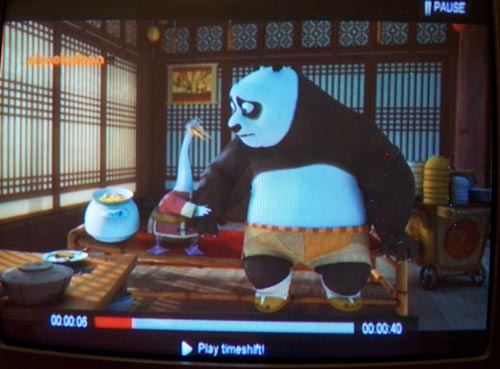La funzione TimeShift è anche chiamata time shift. TimeShift è una funzione molto utile che consente di "mettere in pausa" una trasmissione televisiva, come su un videoregistratore. Supponiamo che non sia necessario spiegare quanto ciò sia rilevante: spesso è abbastanza difficile staccarsi dallo schermo della TV e, per prepararsi una tazza di tè o fare una telefonata, bisogna aspettare una "pausa pubblicitaria". Con la funzione Time Shifting, è possibile interrompere la trasmissione di un programma TV in qualsiasi momento e poi riprenderla dallo stesso punto e ora in cui è stata interrotta.

Molti decoder satellitari digitali ora hanno questa funzione, che hanno una porta USB integrata.
TimeShift funziona secondo il seguente principio: non appena si preme pausa, il ricevitore inizia a registrare la trasmissione sul dispositivo USB collegato (chiavetta USB, disco rigido). Allo stesso tempo, l'immagine effettivamente "si blocca" sullo schermo.
Quando si mette in pausa un programma TV, il ricevitore deve iniziare a registrare il video, codificarlo, prepararsi alla registrazione e riproduzione simultanee e sincronizzare il suo funzionamento. Questo processo di preparazione può richiedere fino a pochi secondi.
Non appena si è pronti a tornare a guardare il programma TV, si preme il pulsante di riproduzione e il programma TV continua dallo stesso momento in cui è stato messo in pausa. Allo stesso tempo, si verificano due processi: la registrazione del canale di trasmissione in tempo reale in un file di buffer sull'unità USB collegata e la riproduzione dello stesso file. Di conseguenza, si vede sullo schermo della TV ciò che è stato mostrato in TV qualche tempo fa. Allo stesso tempo, i ricevitori offrono la possibilità di controllare la scala di time shift, consentendo di riavvolgere il programma TV avanti e indietro. In qualsiasi momento, è possibile disabilitare il time shift, continuando a guardare il programma TV in tempo reale.
